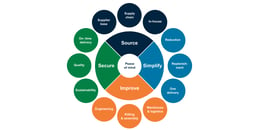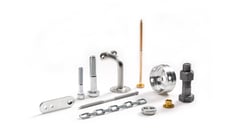- Insights
- The Solutionists Hub
- Defining the Objectives of C-Parts Supply Chain Management
Defining the Objectives of C-Parts Supply Chain Management

Modern C-parts supply chains are complex things. For a major manufacturer purchasing C-parts for use in production, the structure of the supply chain and the thinking behind it is a complicated mix of priorities. I will explain in this article that finding a balance between these priorities can be a challenge.
A supply chain is a sequence of processes involved in the journey that goods take on their way to the point of use, starting with the initial planning stage and continuing beyond the point a customer receives a finished product. In every supply chain, the key objective is for the journey to flow as smoothly as possible, allowing your company to do business without any obstacles.
In some cases, there will be objectives and needs to satisfy that are unique to a company, an industry or a finished product. The challenge for a decision-maker is not only to define these kinds of objectives, but also to find a solution that creates a friction-free supply chain.
To start with, let’s look at some primary objectives that all manufacturers have for their supply chain management work.
High availability
This is probably the most fundamental objective of all C-parts supply chains. You need to manage your supply chain so that the parts you need are available when you need them. If you regularly experience C-parts shortages, then the supply chain is broken. A lack of C-parts on the production line leads to expensive downtime, so whether your availability issues are down to stock control, supply chain disruptions or difficulty in managing the C-parts, you’re in trouble.
Lowering cost of ownership
Keeping costs as low as reasonably possible is an important objective in all supply chain management projects. Since C-parts are such low-value items, this doesn’t mean the actual purchase price of the parts – which is typically negligible in the grand scheme of things. It’s more important to consider the total cost of ownership (TCO) – in this case, the combined indirect costs of sourcing, purchasing, receiving, storing and restocking the C-parts. These costs typically comprise around 80% of the TCO, so a supply chain must be well-planned, consolidated and rationalized to bring them down.
Continuity and sustainability
Over the last few years, the fragility of some global supply chains has become clear to many of our clients. So whether it’s through building a more diverse and sustainable base of potential suppliers via a supply chain partner or improving your systems to gain a better overview, ensuring continuity, quality and sustainability will help you achieve your business objectives.
Regardless of the nature of your company or your industry, these three points will likely be key objectives of your supply chain management efforts.
It is likely there are more objectives than these that are specific to your company and its unique needs and challenges. They might not be as easy to define, but they remain fundamental to the solution when handling the supply chain.
The need for an expert partner
Most companies would benefit from an outside perspective when defining the objectives of their C-parts supply chain management solution. It’s easy to think that supply chain questions begin and end with production, but in reality, the entire company needs to be involved – from IT and finance to logistics and purchasing.
Some ready-made C-parts solutions meet your objectives, but if they change in the future or if you’re focusing on the wrong objectives, your business risks stagnating.
Many C-parts suppliers are happy to provide a single, off-the-shelf solution that helps you meet your objectives. However, these kinds of solutions are often inflexible – you can compare them to one of the many meal delivery services currently on the market. You choose what you want to eat from a list of options, and the company takes care of sourcing the ingredients, providing you with the information you need and delivering the product to your door. It’s smooth and easy, but if you want to eat anything else in the middle of the week, you’re stuck. You can only work within the narrow bounds of what you’ve been given, and it’s the same with ready-made supply chain solutions.
They might meet your demands, but they rarely meet your overall business needs, properly define the supply chain management objectives, help plan change in the future or identify if you’re focusing on the wrong drivers. With solutions like these, your business risks stagnating.
Instead, it’s better to take the alternative route and work with a supply chain partner who can analyze your operation and truly understand your business. Since the partner will have a firm grasp of the C-parts supplier base and the different logistics alternatives, they can help define your objectives and uncover how the C-parts supply chain can help you meet them. For example, if your company has a particular focus on sustainability, the right expert partner can help you to set a reasonable objective for reduced carbon emissions in the supply chain, and work to identify potential suppliers who meet these demands.
Put in the work for a better result
No two businesses are the same, so it’s better to find an expert partner who asks the right questions, knows what to do with the answers, listens to understand rather than just reply, and suggests the solution you need – although not necessarily the one they have.
All this naturally involves some extra work. It may require changes to the way you do business, and buy-in from top management will be necessary. But it’s the only way you will be able to define accurate objectives and develop a C-parts supply chain that helps you meet them and drive your business forward.
To keep learning more about C-parts supply chain management, take a look at our in-depth guide on the topic – and make sure to download the free presentation, The Guide to a Seamless Supply Chain of C-Parts.
Get new knowledge every week!
Related
-
By Niklas LindsköldHow do EU sanctions against Russia affect your C-parts operation?
-
By Jaroslaw BazeliSupply Chain Strategy Definitions You Should Know
-
By Slawomir BieszkSupply Chain Management Risks, and How to Handle Them
-
By Rob KoningsHow Does the C-Parts Supply Chain Management Process Work in Practice?
-
By Jacob BergströmSupply Chain Challenges and How to Overcome Them
-
By Sergio BrambilaSustainable Supply Chain: How to Reduce Your Carbon Footprint
-
By Jacob BergströmSupplier vs. Supply Chain Partner: What to Choose?









